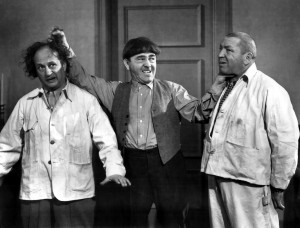Please note: this article contains three references to genital injury, two of them illustrated. You have been warned.
Plato said that comedy comes from enjoying the suffering of others. Aristotle argued that comedy comes from the ridiculous or from deformities that cause laughter but do not injure us. Shakespeare thought that comedy came from identity theft, thinly veiled sex jokes, social inversion, and marriages. Thomas Hobbes noticed that “we laugh when we feel superior to others.” Freud believed that we laugh with relief when we find our fears to be unfounded. Mikhail Bakhtin called comedy the “peculiar logic of the ‘inside out.’” Mike Meyers was certain that comedy occurred any time he did a Scottish accent.
On August 9, 2010, researchers from the University of Colorado – Boulder released the results of a new study, claiming to have figured out exactly what makes things funny. Setting aside all those previous attempts to isolate the “funny” gene, they propose the following: “humor comes from a violation or threat to the way the world ought to be that is, at the same time, benign.”
You can read the press release here, and should. It’s short, and it’ll make sense of the rest of this article.
A test of this hypothesis presented two scenarios to test subjects: one in which the Jimmy Dean sausage company hires a farmer as a spokesperson, the other in which ol’ Jimmy hires a rabbi. While neither case sounds particularly amusing, the subjects thought that the rabbi scenario was funnier (everyone knows you can’t go wrong with a kosher joke in Colorado). This supports the first part of their hypothesis: the violation of the natural order – a rabbi hawking pork sausage – is, in fact, humorous.
This is not new territory. From Plato to Bakhtin, the inversion of norms has been a baseline standard for the definition of comedy for a long, long time. We see this a lot in pop culture as the basis for most comedic films. Will Farrell and John C. Reilly were too old to be Step-Brothers. Katherine Heigl would never sleep with Seth Rogen. Blue Oyster Cult didn’t need more cowbell. Knights don’t say “Nee!”
The problem with the McGraw hypothesis comes in its second half: that turning the world upside-down is funny only when it’s a benign threat to the way the world should be. In his press release, Dr. McGraw suggests that previous theories of social inversion, superiority, or the release of tension would all hold true if you were to kill your spouse, but that killing your spouse isn’t funny because someone is actually getting hurt. Using another odd set of scenarios in which a church and a credit union each raffle off an SUV to raise money, he claims to prove that we only like our comedic disorder if there’s no real threat.
And that’s just complete crap.
First of all, I imagine that most people who kill a spouse generally feel a lot more tense and rarely notice a sense of social inversion. But even granting his point, there are entire genres of fictional comedy dedicated solely to watching people get hurt. As Mel Brooks said, “Tragedy is when I stub my toe. Comedy is when you fall in a manhole and die.” The example that comes to mind is the oeuvre of Ben Stiller, who’s most iconic on-screen moment (other than Magnum) is when he critically injures his penis with a zipper. Anyone who’s played Grand Theft Auto has beaten up some random driver and giggled throughout. Think also of every pratfall, ever.
To be fair to Dr. McGraw, he’s covered this, dismissing all slapstick as benign because it’s fictional and we know that’s it’s not actually happening.
“’We laugh when Moe hits Larry because we know that Larry’s not really being hurt,’ says researcher A. Peter McGraw, referring to humorous slapstick. ‘It’s a violation of social norms. You don’t hit people, especially a friend. But it’s okay because it’s not real.’”
OK, Doc. What about non-fiction slapstick?
America’s Funniest Home Videos has been on the air for 20 years, featuring real people really injuring themselves in a variety of ways (often having to do with an above-ground pool). When it began in 1990, AFV was pulling in more than 38 million viewers every Sunday night at 8:00. After church, barbeques, and a swim in the above-ground pool, 15.4% of America tuned in to watch other Americans hurt themselves and/or others. Even today, 7 million people watch the show. The other 31 million now watch reality shows instead, which are basically the same thing but with psychological damage instead of people falling off of stuff.
We even think it’s funny to watch little kids get hurt. Don’t believe me? Please enjoy this six minute video, a montage of PLAYGROUND ACCIDENTS that played on national broadcast TV.
http://www.youtube.com/watch?v=y3dgqyLABjM&feature=related
The other great modern comedic example of taking pleasure in the authentic pain of others is Jackass. I didn’t watch much of this show, my pretentious college self thinking the show too lowbrow. Then I was dragged to Jackass 2. Someone got things stapled to his ass. It was hysterical.
The guys on this show light themselves on fire, get hit by cars, and perform dozens of similarly painful stunts. In 2008, Johnny Knoxville was filming a motorcycle stunt for Jackass, lost control and, as he put it, “The bike goes about 15 feet in the air, comes down and breaks off the handlebar on my crotch.”
Jackass was insanely popular from 2000 to 2002, and the two Jackass films both opened at #1. Millions of Americans paid $8 to spend two hours watching video of real injuries. And we’re about to do it again for $10-$12.
Jackass was so damn funny that tremendously stupid people seriously injured themselves while attempting to recreate a number of the stunts. Failing to appreciate the Darwin Awardesque utility of those incidents, Senator Joe Lieberman added to his long list of embarrassing panders by condemning the show.
OverthinkingIt.com is a pop-culture blog, so I’ve focused on the fact that, in our media, America clearly thinks that pain and suffering, real or fictional, is funny. But let’s take a minute and do a little psych evaluation of our own. Think about the last time one of your friends took a serious fall, slammed his/her head into something, or took a flying object to the groin.
Seriously. Think about it. Then click through.






I was going to say that It’s Always Sunny In Philadelphia proves that humor does not have to be benign to be funny. However, on second thought, the show is benign, in a sense, because I always know that whatever evil things the characters do, they will always fail in the end. So no one is really going to suffer for that long on the show, except for the “heroes,” who are awful, awful people and thus deserve their comeuppance.
Well, them and Rickety Cricket.
Ah, true. I guess there’s a point where someone’s life gets so ridiculously sad that you just have to start laughing at them.
America’s Funniest Home Videos is funny because the injuries are generally mild, and we assume there will be little long term damage. Similarly, if I see my friend trip down the steps, my first thought is “oh crap! I hope they’re okay!” Once I realize they’re okay, then I’m able to laugh at them for falling down the steps like an idiot. If they broke their leg and had to be taken to the hospital in an ambulance I wouldn’t be laughing at them.
We find the pain of others funny as long as it is benign and we know that there was no serious damage. When Coyote falls off a cliff, we laugh only because we know that Coyote is fine. When we see a squirrel get run over by a car in real life, we don’t laugh because, dude, that squirrel just died.
When we watch a little kid hit his dad in the balls on AFV, we laugh, because getting hit in the balls isn’t a serious injury. In addition, we have a level of distance from the person we’re seeing; we don’t know this person, and thus have no emotional investment in their well being. However, if we were watching a little kid cutting his dad’s hand off with a hack saw, and there was blood everywhere and the dad was screaming and crying, we wouldn’t laugh, because it would feel to real.
I am currently laughing at your example of a child with a hacksaw. I am imagining it in vivid detail. The more realistically I envision this scene the more absurd it feels and the funnier I find it.
Also I have added in a stuffed bunny, who has no limbs.
People find different things funny.
This theory also does nothing to explain something like Dr. Strangelove–that was funny precisely because it was not benign. The scenario presented there was all too real at the height of the cold war. The humor came from exposing how absurd and silly reality was, and how little control the Very Serious people who were making decisions for us actually had over anything.
I guess I’m weird, because I find AFHV kind of disturbing and the concept of Jackass so disturbing that based on description alone I have avoided it like the plague. That video, though, where the dog is asleep and attacking it’s own encroaching leg? Effing hilarious.
The premise of Dr. Strangelove IS benign, as a fictional alternative to actual nuclear annihilation. It’s basically Larry and Moe’s slapstick again, taken to to a nuclear level.
As for watching people get hurt on TV, we are conditioned not to think of them as real people. Doubly so actually, since 1) they are on TV, and 2) they are very far away from us and we will probably never meet them. So that ends up being benign too, at least in our minds, regardless of how long the actual victim spent in traction.
Finally, I think the study works as a basic guide, but the violence/upset being necessarily benign depends greatly on whether the individual laughing is a bad person.
All of the logic used by the characters in that movie was real logic used by real generals and politicans, though (aside from the bodily fluids guy, but part of the point was the effect one crazy guy could have). That film was a statement about where society was then. The absurdism served a very different function than the absurdism in slapstick.
Slapstick is about ‘see, isn’t this crazy and unexpected and funny’? The absurdism makes the story less real, and more clearly fluff entertainment.
Something like ‘Dr. Strangelove’ or ‘Hedwig and the Angry Inch’ uses absurdist humor in order to say ‘hey, things are really, really messed up. The only way I have to communicate the reality of things is by giving you an exaggerated version of reality, and then asking you to connect the dots.’ Here, the absurdism makes the story MORE real–it brings contradictions and problems to a head. We laugh at the doomsday bomb because it scares us about what Kruschev or Gen. Westmoreland may be doing.
I don’t see how a contemporary could watch that movie and not immediately have their worry about Kruschev-Johnson-Nixon Kissinger cold war logic increased.
Still talking about two different things. You can get upset at the real life implications of a thing, but laugh at the movie, which is NOT REAL. We can also recognize Strangelove as being benign because it’s PURPOSE is to raise the awareness you’re talking about. So it is a good thing. But attempts at humor that seem mean-spirited and destructive are less likely to be laughed at by a group of people who are offended by the subject matter. Those who aren’t offended will probably still laugh, because they therefore see it as benign.
Was Hedwig supposed to be funny? Made me feel like bawling.
Hey, as a fan of psychology and of pop culture, I say one duff study doesn’t defeat us… I imagine a more sophisticated review would have a more complicated and comprehensive answer. Good thoughts, though I think it is a matter of taste. There’s a threshold of pain or embarrassment that destroys humour that is different for different people. I don’t really like Peep Show. My grandfather can’t stand Fawlty Towers. Everyone has their pain-as-comedy threshold.
i would agree with the original theory. all that matters is level of empathy, cynicism and corresponding definition of benign accident.
most people don’t laugh at holocaust or 9/11 jokes, on the other hand i can’t really laugh watching movies like Dr.Strangelove, instead i find them depressing (and great).
Laughter can be cathartic. When we see a friend hurt, we care for them until we see that they are okay. The laughter, in this sense, serves to release the tension that we may subconsciously feel towards being injured ourselves, as well as to comfort our compadre that their injury is not so serious
it always feels awkward to laugh at a recent misfortune